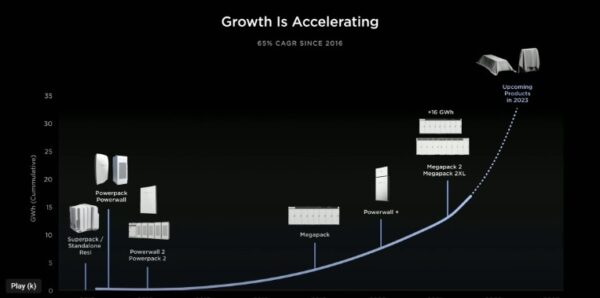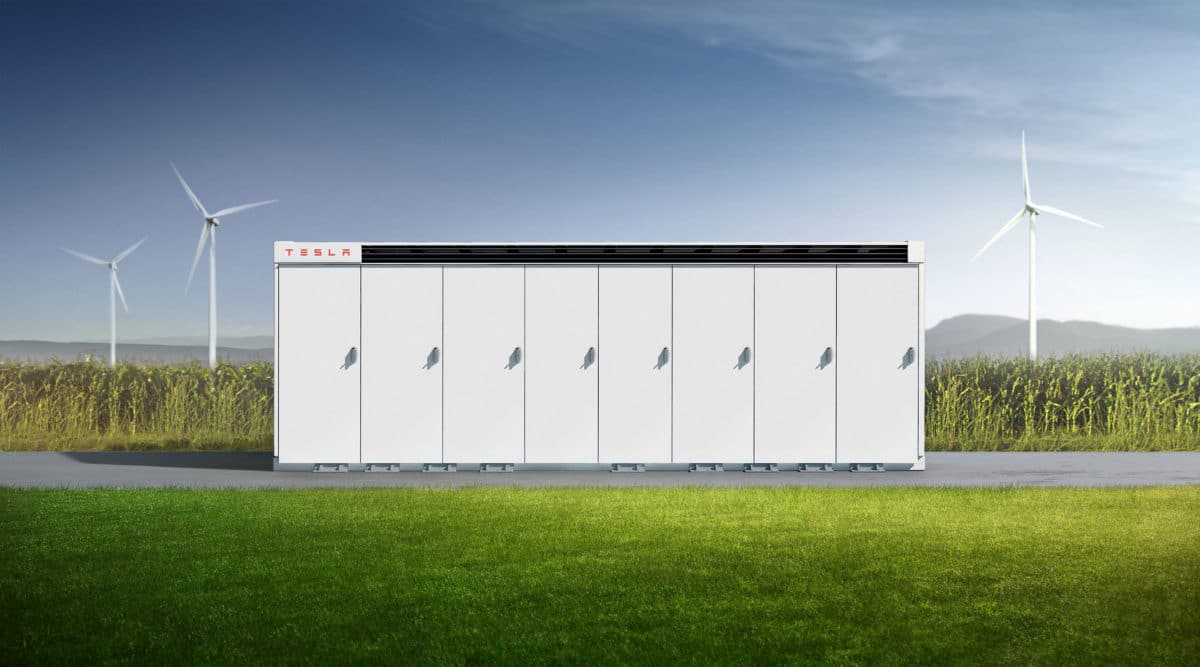From pv magazine USA
At the recent Tesla Investor Day at its Texas Gigafactory in Austin, the electric vehicle (EV) and battery storage manufacturer revealed some interesting tidbits about its Megapack energy storage business. The March 1 Investor Day saw Megapack Senior Director Mike Snyder set a goal of reaching 100 GWh in global Megapack installation in 2023.
Snyder has worked at Tesla for nine years, much of which has been spent in the gruelling work of ramping up Tesla’s Megapack production facilities in the US to meet the increasing demand for its utility-scale stationary storage product. Its Megapack factory in Lathrop, California, fittingly referred to as the “Megafactory” though its the smaller cousin to the four Gigafactories Tesla runs in Austin, Fremont, Berlin and Shanghai, which together churn out 40,000 EVs per week.
According to Snyder over 16 GWh of Megapacks have been installed globally to date. But Snyder sees 100 GWh as the annual run rate for the next few years – a big ramp up after just 16 GWh in the initial 10 years. The latest product is the sixth generation Megapack XL, packing 3 MWh per unit of the lithium-ion battery. Snyder calls the Megapack XL the stationary battery storage product with the highest energy density on the market, capable of packing up to 300 MWh on a single acre of land. According to Snyder that’s twice the power density of a typical gas peaker plant.
Snyder was joined onstage by Drew Baglino, Tesla’s senior vice president of powertrain and energy engineering. Both Baglino and Snyder highlighted Tesla’s mastery of power electronics, with the company “delivering more power electronics than the solar and wind industries combined on an annual basis.” The cumulative output so far has been 1.4 TW across Tesla’s vehicle and stationary storage products. Coupled with Tesla’s extensive in-house capabilities in software development, the Megapack can function in “virtual machine mode,” providing synthetic inertia to the electricity grid.
According to Baglino, it’s no longer simply a matter of injecting clean energy to the grid, but “adding power stability” to the mix. As Megapack costs continue to decline, these utility-scale energy storage units will replace conventional fossil fuel power plants to provide both energy and stability to power grids.

While the 2030 goal on the EV front is to produce 20 million vehicles annually, the 2030 goal on the energy storage front is to hit the 1 TWh mark. According to Tesla this will require an investment of up to $262.5 billion (USD 175 billion), which is actually less than one third of Tesla’s current market capitalization. On the other hand, it’s about five times the amount of Tesla’s cumulative investment so far (USD 28 billion).
As on the EV side, Tesla’s ambitions for its Megapacks are impressive: the long-term goal is to boost annual output to 1 TWh, which would represent 25 x the annual production capacity of the current factory in Lathrop. Lathrop itself was quite an achievement, after Tesla took less than a year to transform a JC Penney distribution center into a state-of-the-art Megapack manufacturing facility.
Speed is also of the essence when it comes to getting Megapack projects built. Snyder highlights the plug & play nature, and notes that Megapacks can be easily strung together to form massive and intelligent power blocks that can readily connect to electricity grids across the world.
In the past four years alone Tesla has increased the installation speed of Megapack projects fourfold, while at the same time reducing the required workforce by a factor of three.
Tesla’s Investor Day also covered developments on the distributed storage front, where Tesla’s Powerwall is the flagship product. Both the Megapack and Powerwall are key elements in Tesla’s vision to get, as Elon Musk phrased it on the day, to a “sustainable energy earth.”
This content is protected by copyright and may not be reused. If you want to cooperate with us and would like to reuse some of our content, please contact: editors@pv-magazine.com.








1 comment
By submitting this form you agree to pv magazine using your data for the purposes of publishing your comment.
Your personal data will only be disclosed or otherwise transmitted to third parties for the purposes of spam filtering or if this is necessary for technical maintenance of the website. Any other transfer to third parties will not take place unless this is justified on the basis of applicable data protection regulations or if pv magazine is legally obliged to do so.
You may revoke this consent at any time with effect for the future, in which case your personal data will be deleted immediately. Otherwise, your data will be deleted if pv magazine has processed your request or the purpose of data storage is fulfilled.
Further information on data privacy can be found in our Data Protection Policy.